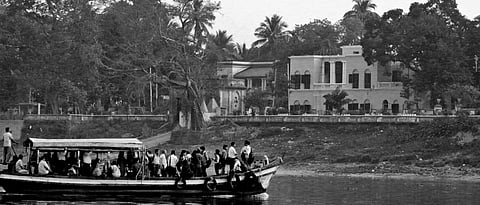
- Destinations
- Experiences
- Stay
- What's new
- Editor’s Picks
- Responsible Tourism
- CampaignsCampaigns
- Subscribe

A fragment of the history of the town of Serampore in Hooghly district of West Bengal when it was under Danish rule will come alive onFebruary 28when the lovingly-reconstructed Denmark Tavern, which is visible from the Hooghly river flowing past, is thrown open to the public. Serampore is better known for its associations with the advent of Bengali printing and publishing, but it was under the administration of Denmark from 1755 to 1845, when the Danes sold their Indian interests to the UK. Thanks to trade during that period, some local Bengali families like the Goswamis flourished and prospered and constructed magnificent mansions here. In 1786, the British innkeeper, James Parr, opened the Denmark Tavern & Hotel in Serampore that became quite famous among Europeans. But for a long time it has been in ruins. Its spiral staircase collapsed, and Serampore police lines occupied a part of the building.
Among the heritage buildings left behind by the Danes are the Government House in the court compound, the lofty gateway that leads to the compound, St Olavs church, and the Denmark Tavern all at the centre of this town located close to the Hooghly river. After painstakingly restoring the church, and while work continues in the court compound, the National Museum of Denmark (NMD), along with the state heritage commission and INTACH, under the Srirampur Initiative that started in 2008, have quietly reinvented the tavern that, instead of being a high-end restaurant, is now meant to be a noshery for the enjoyment of local people. At the church, which was closed for a long time, prayers are being held regularly after restoration. Local parishioners attend the prayers. The National Museum of Denmark, along with the philanthropic body Realdania, enabled the five-year programme to restore the heritage structures, all of which are in the state government's custody.Bente Wolff is the project head, while architect Flemming Aalund, along with historian Simon Rasten, has produced the admirable brochureThe Indo-Danish Heritage Buildings of Serampore,that documents the history of this once-Danish town. The ultimate goal of the initiative is to give the square in the heart of Serampore, where these landmarks are located, a harmonious look. The project was executed under the supervision of conservation architect Manish Chakraborti.
This is a perfect example of adaptive use of a historic structure. Apart from the cafe, there is provision for accommodation too. Instead of wood originally used in the roof and the intermediate floors, steel beams were used to strengthen the structure, and compatible, breathable lime-sand plaster replaced cement that had been earlier used for repairs. The new and old blend seamlessly, but there has been no attempt to camouflage the intervention.
How to get there One can reach the Denmark Tavern by river and by train as well. There are frequent ferry services between Dhobi ghat in Barrackpore to the Serampore jetty on the other side of the Hooghly. The tavern faces the Ladys ghat or Nishan ghat.
To reach Serampore by train, one should go to Howrah Station. Thereafter, one can take an electric rickshaw from outside the station to reach Serampore court. It takes a couple of minutes only. The tavern, adjacent to the bungalow of the sub-divisional officer, is just a minute away. The strand is wonderful for a walk, anyway.
One can also use the ferry service from Barrackpore Dhobi ghat. Its a wonderful experience. The steeple of St Olavs church is visible from the ghat.
